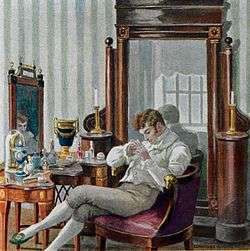Elena Samokysh-Sudkovskaya

Elena Petrovna Samokysh-Sudkovskaya, née Besnard (Russian: Елена Петровна Самокиш-Судковская; (1863, Saint Petersburg -1924, Paris or Vyborg) was a Russian painter and illustrator.
Biography
Her father was a military engineer of French ancestry and she received her secondary education at the "Pauline Institute for Women", a school for young girls of the nobility. Then, she studied drawing in Helsinki and took private classes in the workshop of V.P. Vereshchagin.[1] In 1883, she married the Ukrainian painter, Rufin Sudkovsky, but he died of typhus only two years later.[2] To help her cope with her grief, she moved to Paris and took more lessons at the private academy of Jules Bastien-Lepage.
In 1889, she married another painter, Mykola Samokysh, and returned to Russia, where she worked as an illustrator for Niva, the most popular magazine in the Russian Empire at that time.[1] She was especially known for her color illustrations in the Christmas and Easter additions and the annual calendar. She also created posters, advertisements and theater programs.
She became a member of the "First Lady's Artistic Circle" (which existed from 1882 to 1918) and exhibited alongside some of the most prominent painters of that time, including Ivan Shishkin and Ilya Repin.[2] Her designs for Tsar Nicholas II's Coronation Album received an award of excellence, with a medal and blue ribbon.
Although she painted numerous portraits and genre scenes, she is probably best remembered for her book illustrations; notably the ones for Eugene Onegin by Pushkin, which were done in 1911, and those for The Little Humpbacked Horse by Yershov.[1] Occasionally, she collaborated with her husband, producing illustrations for Dead Souls by Gogol (published by Adolf Marks in 1901) and murals for Tsarskoye Selo railway station, depicting the history of the Tsarskoye Selo Railway.[2]
She fled to Vyborg during the Revolution, then left her husband and lived in Paris during the Civil War.[2] It is generally believed that she stayed in Paris after the war was over, and died there, although some sources indicate that she returned to Vyborg.
Illustrations from Eugene Onegin
-
_11.jpg)
Title Page
-

Onegin in His Study
-

Onegin and Tatiana
-

Tatiana
References
- 1 2 3 Brief biography @ Yandex.
- 1 2 3 4 Brief biography @ Лаборатория Фантастики.
External links
| Wikimedia Commons has media related to Elena Samokysh-Sudkovskaya. |
- Album of photographs and illustrations from the library of Saratov State University.